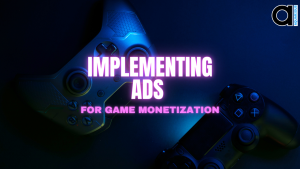Implementing Ads for Game Monetization

Game development is a labour-intensive endeavour that requires immense creativity, skill, and dedication. As the gaming landscape evolves, developers deserve to be rewarded for their efforts not only through player engagement but also through sustainable revenue generation. This is where the concept of game monetisation ads comes into play.
Understanding Game Monetization
Understanding game monetization involves grasping the strategies and techniques used to convert a game’s popularity and engagement into sustainable revenue. It’s the process of strategically integrating various monetization methods, including in-app purchases, premium versions, and game monetisation ads, to strike a balance between financial success and user satisfaction. Game developers navigate the intricacies of selecting appropriate monetization avenues that resonate with their target audience, enhancing their gaming experience while generating a steady income. Ultimately, comprehending game monetization means recognizing how to harmonize creative gameplay with effective revenue-generating mechanisms.
The Role of Ads in Game Monetization
The role of ads in game monetization is two-fold: revenue generation and user experience enhancement. Ads serve as a revenue stream for developers and publishers, helping to finance ongoing game development and support. When skillfully integrated, ads contribute positively to the gaming experience by blending seamlessly into the virtual world, creating a cohesive and immersive environment. By strategically placing ads that align with the game’s context and engaging format, developers can strike a delicate balance between financial success and player satisfaction, ultimately ensuring a win-win scenario for both creators and gamers.
Choosing the Right Ad Format
Selecting the appropriate ad format is a pivotal decision that influences the success of game monetization. Each game genre and target audience may warrant a different approach. Here are some popular ad formats to consider:
-
Native In-Game Ads
Native in-game ads are seamlessly integrated promotional elements that match the game’s aesthetics, narrative, and user experience. These ads become an organic part of the virtual environment, enhancing immersion without disrupting gameplay. By harmonizing with the game’s art style and context, native in-game ads avoid feeling intrusive and offer a subtle yet effective way of monetization. Players engage with these ads as part of the gaming experience, making them an integral component of modern game monetization strategies.
-
Interstitial Ads
Placed between natural breaks in the gameplay, interstitial ads ensure that players encounter them during transitions or loading screens, minimizing disruption.
-
Rewarded Video Ads
Rewarded video ads present players with the option to watch an advertisement in exchange for in-game rewards, such as extra lives, virtual currency, or power-ups. This approach incentivizes ad engagement.
Strategies for Implementing Ads
Strategies for implementing game monetisation ads involve thoughtful approaches to ensure effective revenue generation while maintaining an engaging user experience. Native in-game ads seamlessly integrate promotional content, blending with the game’s visuals and narrative to enhance immersion. Interstitial ads, placed between gameplay segments, minimize disruption and allow players to engage during natural breaks. Rewarded video ads offer a voluntary engagement model, where players opt to watch ads in exchange for in-game rewards, increasing ad effectiveness.
Successful implementation requires aligning ad formats with the game’s genre and demographics. Developers must prioritize user experience, strategically placing ads where they don’t hinder gameplay. Analyzing metrics like Click-Through Rates (CTR) and Effective Cost Per Mille (eCPM) helps refine strategies. Striking a balance between ad frequency, relevance, and gameplay is paramount to ensure that ads harmonize with the gaming environment while contributing to sustainable revenue.
Ensuring User Experience
Maintaining a positive user experience is paramount when integrating ads into games. Advertisements should complement the gameplay rather than detract from it. Here’s how:
-
Ad Integration with Gameplay
Ads should make sense within the context of the game. For instance, a medieval fantasy game could incorporate ads for fictional in-game products like potions or magical items.
-
Frequency and Intrusiveness
Striking a balance between ad frequency and gameplay is crucial. Bombarding players with ads can lead to frustration, while infrequent ads may not generate optimal revenue. Finding the middle ground is essential.
Optimizing Ad Placement
Strategic ad placement significantly influences ad performance and player engagement. Consider the following:
- Loading Screens: Players often pay attention during loading screens, making them an opportune moment for displaying ads.
- Transition Points: Between levels or major gameplay sections, players are more likely to tolerate ads as they’re anticipating a brief pause.
- In-Game Billboards or Objects: For immersive games, incorporating ads into the environment, like billboards or objects, can enhance realism.
Measuring Ad Performance
Analyzing ad performance helps developers refine their monetization strategy. Two essential metrics to monitor are:
-
Click-Through Rates (CTR)
CTR indicates how often players interact with ads. A higher CTR implies that players find the ads relevant and engaging.
-
Effective Cost Per Mille (eCPM)
eCPM measures the estimated earnings from a thousand ad impressions. It helps gauge the overall revenue potential of ad monetization.
Common Challenges and How to Overcome Them
-
Ad Relevance and Context
Ensuring that ads are relevant to the game’s theme and target audience enhances user engagement. Ads that feel out of place can disrupt immersion.
-
Balancing Monetization and User Experience
Striking a delicate balance between generating revenue and maintaining a satisfying user experience is an ongoing challenge. Players should never feel that ads compromise their enjoyment.
Future Trends in Game Monetization
The landscape of game monetization is continually evolving. Some future trends to watch out for include:
- Personalized Ads: Advertisements tailored to individual player preferences and behavior could lead to higher engagement and revenue.
- Augmented Reality Ad Experiences: With the rise of augmented reality (AR) gaming, ads that blend the virtual and real worlds could provide innovative monetization opportunities.
- Dynamic In-Game Product Placements: Games could feature real-time ads for products, offering developers a new stream of revenue.
Conclusion
Integrating ads into game monetization is a strategy that demands finesse and careful consideration. By selecting suitable ad formats, optimizing their placement, and prioritizing user experience, developers can unlock a sustainable revenue stream without compromising the essence of the game. Advertisements, when seamlessly integrated, have the potential to become an organic part of the gaming experience, benefiting both players and creators.
-
14
+Category
-
98
+Post
Top Categories
Popular Posts
- The Power of Prototyping in Software Development
- Version Control Best Practices for App Development
- Understanding Visual Hierarchy: A Guide to Effective Design
- Crafting Intuitive Navigation: A Guide to Seamless User Experience
- Choose Your Best Cloud Provider
- Making the Leap: Transitioning from Manual to Automated Software Testing
- Using GitHub- Advantages and Disadvantages
- E-commerce Product Photography on a Budget
- Tech Innovation in Developing Countries
- Smart Cities: How Technology is Shaping the Urban Landscape
- Principles of Composition: Creating Visual Harmony with Composition
- Exploring Cross-Platform App Development
- Why Regular Website Updates Matter
- Navigating Effective Facebook Audience Targeting
- Implementing Ads for Game Monetization
- Designing User-Centric Mental Health Apps: Enhancing Well-being in the Digital Age
- NFTs and Collectibles: Creating NFT App Solutions for Collectors and Enthusiasts
- Successful Implementation of Enterprise Apps
- Maximizing Business Impact with EQ
- Proven SMO Ads Optimization Tips (2023)






